This was published 8 years ago
The extremes of backcountry skiing in Kosciuszko's high wilderness
By Daisy Dumas
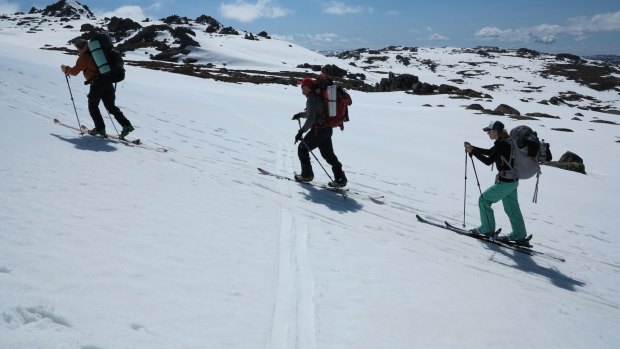
Daisy Dumas, Dave Herring and Adam West of Main Range Back Country, backcountry skiing, Thredbo.Credit: Tim Peltz
There are no lifts to take you there, no hot chocolates half way, no ski patrols manning the slopes for your convenience. There is, however, a guaranteed long, uphill slog and the sheer bliss of a descent that has been earned the hard way.
It's taken 34 years for me to strap skins to the undersides of touring skis and to hike – rather than rely on ski lifts – to the tops of mountains I want to ski down. I've trudged many times, skis strapped to my backpack, to find clean powder in Canada and Europe, but this is the first time I've gone the whole hog, trekking into the high wilderness and bunkering down overnight to find hidden valleys, remote steeps and the deep sense of stillness that comes from leaving civilisation for days. Ski touring, when done properly, is as much about communing with the extremes of remoteness and silence as it is about the rush of powder skiing. It is a sport that rewards the determined and the patient.
So, as our chorizo sizzles on a gas burner that is punching through the minus five degree Celsius night sky and gusty winds, not quite sheltered by a half snow cave we have dug into the side of a deep windlip, sharing mugs of red wine, warming us from the inside – though not getting anywhere near our ice-block like feet – I do a quick life stock-take. Here I am, in the pitch black, at 1850 metres, about to sleep on the snow, in the freezing cold, in an area I know almost nothing about, with no phone reception, little decent warmth and almost nothing in the way of creature comforts. Yesterday I was at work in Sydney. As uncomfortable as the creeping cold may be, this is a true break from the city. It's a deliciously unnerving, awakening feeling.
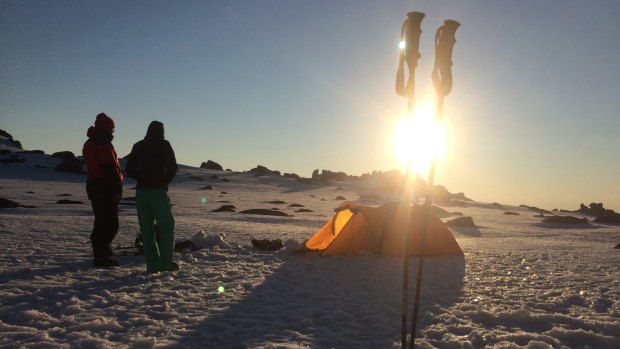
Backcountry skiing, Thredbo.Credit: Tim Peltz
We didn't sleep. Or at least Tim, my boyfriend and trip photographer, didn't. Nor did Adam West, one of our guides, whose inflated sleeping mat went pffffff in the night. Still, there's nothing like waking up in a snow camp, in spitting distance of Australia's highest point, 2228-metre Mount Koszciuszko, to blue skies, sharp, clean air and fresh tracks as far as the eye can see.
Like backcountry, sidecountry – or lift-accessed backcountry – skiing has seen a massive leap in popularity in North America and Europe in recent years, a chicken and egg growth fuelled by mainstream access to once-specialist equipment, ever-more extreme skiing films and the increasing marketability of stretches of resort-side powder that don't require a two-day hike to reach. Loop around an out-of-bounds fence to reach fresh powder just metres from a piste and you've made it into the sidecountry. It's no wonder, then, that the label has been criticised for giving skiers a false sense of security - simply because you can see a piste marker or a T-bar from where you are, it's still the backcountry when it comes to the risks involved.
But as much as the backcountry may be beckoning, there is no way skiers and snowboarders should tackle the unpatrolled unless they are educated in its shifting, inspiring and at times malevolent ways. Understanding and being ready for what lies beyond the patrolled ski zone is a non-negotiable element of backcountry skiing – and a lesson that many Australians would do well to learn before they take on the backcountry pitches of North America and beyond. Last winter's death of legendary backcountry master JP Auclair, highlighted the inherent dangers of the sport. The US recorded nine deaths from avalanches in its 2014/15 season and none of those skiers and boarders were inbounds. Seventy-five avalanche deaths had been recorded across Europe by February 10 of the 14/15 season.
Water is constantly at hand, as are the chocolates and nuts we've brought for easy energy.
Australia's backcountry is not especially avalanche prone, though slides are not uncommon.
Martie Buckland and Daniel Kerr died in an avalanche less than a kilometre from their campsite on Mount Bogong in the Victorian Alps last July. The experienced backcountry snowboarders were equipped with avalanche beacons, probes and shovels, but Kerr's body was found buried under four metres of snow and debris.
They say there is more snow cover in Australia than there is in Switzerland. We mightn't have the steeps of Europe or the powder of Japan, but we do have a booming ski market and a relatively easily accessible and stable backcountry playground that lends itself to the touring newcomer, making an ideal training ground for those who might want to take on the backcountry abroad.
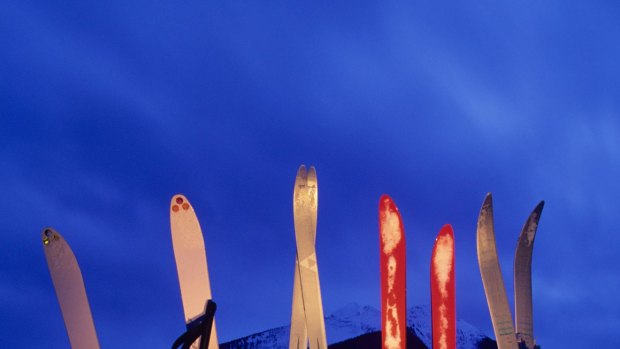
Backcountry skiers' skis stand propped snowbank,Credit: Alamy
What started as a "bit of fun" for Dave Herring, his wife Pieta and their friend Adam has now morphed into Main Range Backcountry guiding, providing backcountry ski touring, avalanche safety and mountaineering courses in the Snowy Mountains. Based in Jindabyne, the pioneering outfit has Canadian Avalanche Association qualifications, and the team of three is armed with a vast knowledge of both the area and the need for safe and sustainable touring training. They are laid back and good fun, their stories as forthcoming as their shared wisdom, from their duty of care towards Kosciuszko National Park to Adam's anecdotes from his annual SplitFest backcountry festival.
The spring sun hadn't heated up on the morning we lumbered towards Thredbo's Crackenback chairlift on our hired touring kit – Harro's Snowsports at Lake Crackenback has plenty of experience in this area – armed with a $35 single-ascent lift ticket. On our backs is absolutely everything we need for the overnight trip: tents, food, cooking equipment, avalanche pack and medical kit, back-up skins and tech gear, clothing, sleeping bags, inflatable sleeping mats, personal stuff, water and, um, poo tubes.
Bearing in mind that everything – and I mean everything – has to be taken off the mountain with us, plastic bags of human waste will be stuffed into rigid plastic tubes that are stoppered and tied to the outside of our packs. This is about the only point in the proceedings when the freezing weather comes in handy, rendering the tubes' contents as odourless as they are rock solid. Still, it's not a pretty process.
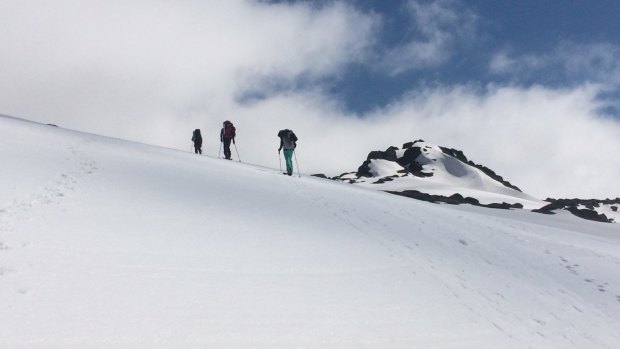
It's not easy going, cross-country skiing uphill in ski boots and wearing heavy backpacks.Credit: Tim Peltz
It's not easy going, cross-country skiing uphill in ski boots and wearing heavy backpacks. Water is constantly at hand, as are the chocolates and nuts we've brought for easy energy.
Camp, tucked into a windlip and under a sharp, boulder-edged rock formation, takes an hour or so of digging and stomping to create flat, hard-packed bases for tents, a snow table and chairs, and as much protection as possible from the winds that are forecast during the night.
Dave digs a box-shaped hole into the side of a deep, clean snow wall, leaving a downward-pointing cone of snow on its upper side. He sits a pot under the cone, which soon begins to drip, a slow water tap for tea or coffee later. The life-affirming value of a hot drink in very cold climes should never be underestimated – even if it stays warm for no more than four minutes.
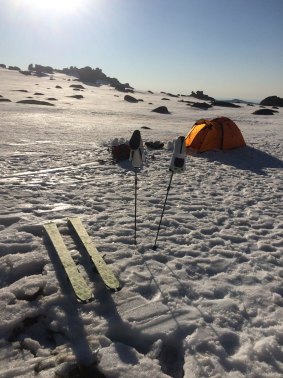
Tent in the snow.Credit: Tim Peltz
Around us, the Ramsheads, Lake Cootapatamba, Rawson Pass and Seaman's Hut are out there, shrouded by thick, low-hanging clouds. There is only one way to fight the chill on that first afternoon in our new playground, and that is to keep moving.
Leaving our boots in walk mode, we hook, stick and coax our skins, which have been hanging to dry, onto our skis. We lengthen our extendable ski poles and clip into the fronts of the touring bindings, which allow full movement of our heels. We slowly inch out of camp, heading uphill and south-west towards Leatherbarrell Creek towards Victoria. Along the way, Adam "checks in" on a GPS chart that plots our course so our progress can be checked at MRBC's HQ. Heavy clouds roll in and, after a dream-like ski – a half a kilometre descent on untouched spring powder – down to the tip of the state, ending only when we reach the snowline of naked, silver gum trees, we have a long climb back to our tiny base, sun setting as we arrive in a late season white-out.
The next day, after that stunted sleep, is a different story when we once again clip into our bindings and start walking towards Kosciuszko. The bowl where the headwaters of the Snowy River rise is infamous for disorientation in bad weather, but today its harsher side is hard to appreciate under clear skies and with the twinkle of snow crystals lighting up every ridge and gully. Sounds muffled by snow, all of Australia below us, we push beyond the tracks left by others to the south eastern tip of the summit and, removing our skins, clicking our boots into ski mode and reaping the reward of the effort, drop onto the flawless steep, our whooping group leaving chains of figures of eights behind as we go.
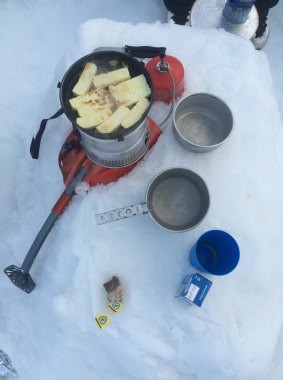
Skiing is a hungry hobby.Credit: Tim Peltz
TRIP NOTES
MORE INFORMATION
GETTING THERE
Drive from Sydney, six hours, or fly to Canberra and drive 2.5 hours.
STAYING THERE
Stay in Jindabyne then camp with Main Range Backcountry (MRBC). For accommodation details, see nationalparks.nsw.gov.au/Kosciuszko-National-Park/Jindabyne-Visitor-Centre/tourist-information
SEE + DO
Main Range Backcountry has a range of avalanche training, alpine touring, backcountry skills tours and mountaineering courses. A four-hour backcountry touring skills course for two people is $100pp. Prices for longer courses and overnight tours on request. See mrbc.com.au.
For touring skis rental, see Harro's Snowsports, harrosnowsports.com.au.
The writer was a guest of Main Range Backcountry.
Sign up for the Traveller Deals newsletter
Get exclusive travel deals delivered straight to your inbox. Sign up now.